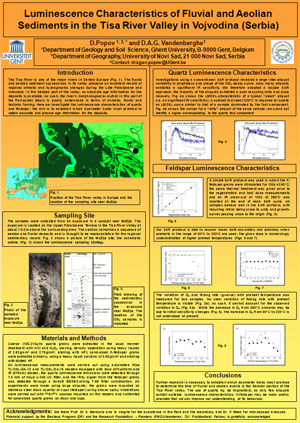LOESSFEST'09 | Aug. 31st – Sept. 3rd, 2009 |Novi Sad-Serbia
Luminescence Characteristics of Aeolian and Fluvial Sediments in the Tisa River Valley in Vojvodina (N Serbia)
Popov, D.1,2, Vandenberghe, D.A.G.1
1Laboratory of Mineralogy and Petrology (Luminescence Research Group), Department of Geology and Soil Science, Ghent University, Krijgslaan 281 (S8), B-9000 Ghent, Belgium
2Department of Geography, Faculty of Science, Novi Sad University, Novi Sad, Serbia
The Tisa river is one of the major rivers in Central Europe; rising in the Ukraine and flowing into the Danube in Vojvodina (N Serbia), the river drains an area of more than 150.000 km2. The aeolian and fluvial sediment successions in the Tisa river valley preserve an excellent record of regional climatic and hydrographic changes during the Late Pleistocene and Holocene. At least in the Serbian part of the valley, no absolute age information for the deposits is available. As such, the river’s morphological evolution in this region of the Pannonian Basin is poorly understood in terms of climatic, tectonic and anthropogenic forcing.
 In this paper, we report on a first series of investigations into the potential
of optical dating to establish the time of aeolian and fluvial sediment deposition
in the Tisa river valley in Vojvodina. More specifically, we investigate the optically
(OSL) and the infrared (IRSL) stimulated luminescence characteristics of
quartz and feldspar, respectively; the aim is to establish which dosimeter holds
most promise to obtain accurate and precise age information for the deposits. The
samples (n=17) were collected from an exposure in a sand pit neat Mužlja, which
is though to be representative for the regional sedimentary record. The luminescence
characteristics of sand-sized (i.e. some fraction in the 63-250μm range)
quartz and K-feldspar grains were investigated using a single-aliquot regenerativedose
(SAR protocol).
In this paper, we report on a first series of investigations into the potential
of optical dating to establish the time of aeolian and fluvial sediment deposition
in the Tisa river valley in Vojvodina. More specifically, we investigate the optically
(OSL) and the infrared (IRSL) stimulated luminescence characteristics of
quartz and feldspar, respectively; the aim is to establish which dosimeter holds
most promise to obtain accurate and precise age information for the deposits. The
samples (n=17) were collected from an exposure in a sand pit neat Mužlja, which
is though to be representative for the regional sedimentary record. The luminescence
characteristics of sand-sized (i.e. some fraction in the 63-250μm range)
quartz and K-feldspar grains were investigated using a single-aliquot regenerativedose
(SAR protocol).
Initial investigations focussed on quartz; all samples emitted dim OSL signals
that decay slowly as a function of stimulation time. The majority of the aliquots
exhibited poor characteristics in terms of recycling ratio, recuperation and dose
recovery. Experiments using linearly modulated OSL show that the quartz OSL
signal is not dominated by a fast component; phospherence is an additional complicating
factor, mainly due to the low intensity of the OSL signals. High preheat
and cutheat temperatures are more effective in isolating a quartz OSL signal that
is dominated by a fast component, but the poor measurement precision limits the
use of the dosimeter considerably.
Research efforts therefore concentrated on K-feldspar. A simple SAR protocol was applied, which used IR stimulation at 50°C and identical preheat treatments for the natural, regenerative and test doses. As the K-feldspar grains were found to be extremely bright, the aliquots consisted of only a few tens of grains and their IRSL signals were detected through a reduced aperture. All samples behave well in the SAR protocol, with recycling ratios being close to unity and growth-curves passing close to the origin. Interestingly, dose recovery test indicate a dependence of measured dose on preheat temperature. While preheat treatments (60s duration) ranging from room temperature to ~220°C yield measured to given dose ratios that are equal to unity, the given dose is increasingly underestimated using higher preheat temperatures. Experiments are underway that attempt to understand this dependence. All samples suffer from anomalous fading, with laboratory fading rates (g2days) of ~2% being measured (using a preheat treatment of 1 min at 250°C); it remains to be established whether the fading rate is also dependent on preheat temperature. As the growth curves are linear in the dose range (a few tens of Gy) under consideration, it should be possible to correct for fading, although it is desirable to reduce the size of the correction.
Owing to the poor quartz luminescence characteristics, we conclude that luminescence dating of K-feldspar holds most promise to determine the time of aeolian and fluvial events in the Serbian Tisa river valley. There is every reason to hope that we can improve our understanding of the behaviour this dosimeter and thereby provide an accurate and precise time frame for the deposits.



